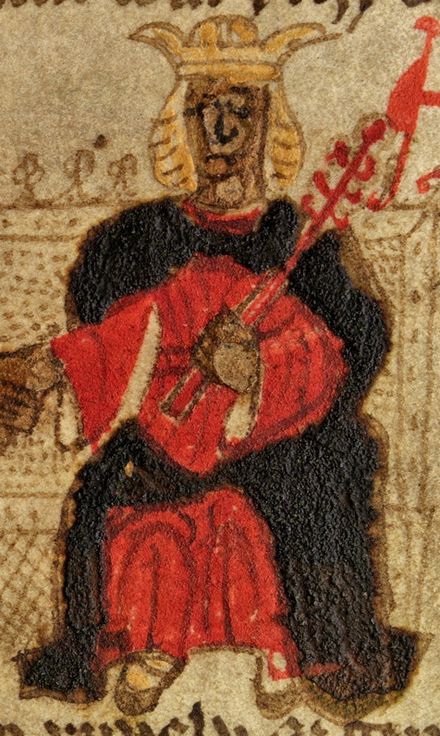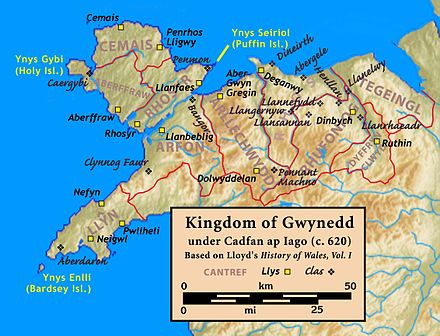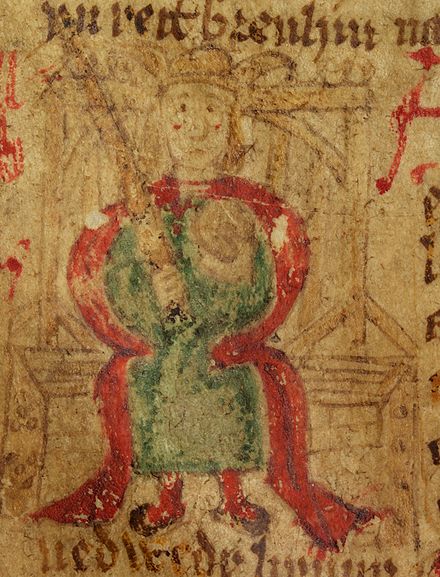The
Gwynedd Dynasty founded Wales and the
Kingdom of
Gwynedd. The Kings of Scotland and the Royal Family
are all
descended from them. They are among the earliest documented Welsh royal
lines.
The names in the line presented below are listed in the book "Medieval
Welsh Ancestors of Certain Americans"
by Carl Boyer 3rd (2004) pp.
66-71. There are also linked Wikipedia articles on each person. |
01. King Cunedda ap Edern (a.k.a. Cunedda Wledig)
 was born
abt. 386 AD and died in 460. He was an important early Welsh leader, and the
progenitor of the royal dynasty of
Gwnyedd.
His grandfather, Padarn Beisrudd may have been a Romano-British official of
high rank who was charged with fighting the Picts in Scotland. Cunedda
is thought to have travelled to North Wales to defind the area against the
Irish; an area which became Gwnyedd. His successors continued
his military skills and set up a powerful kingdom within Wales. The
word "Wledig" is often associated with his name to reflect a position within
the Roman hierarchy. Probably celebrated for his strength, courage, and ability to rally the beleaguered Romano-British forces of the region, he eventually secured a politically advantageous marriage to
Gwawl, daughter of Coel Hen, the Romano-British ruler of Eboracum (modern York), and is claimed to have had nine sons. The early kingdoms of Ceredigion and Meirionnydd were supposedly named after his two sons Ceredig and Meirion. was born
abt. 386 AD and died in 460. He was an important early Welsh leader, and the
progenitor of the royal dynasty of
Gwnyedd.
His grandfather, Padarn Beisrudd may have been a Romano-British official of
high rank who was charged with fighting the Picts in Scotland. Cunedda
is thought to have travelled to North Wales to defind the area against the
Irish; an area which became Gwnyedd. His successors continued
his military skills and set up a powerful kingdom within Wales. The
word "Wledig" is often associated with his name to reflect a position within
the Roman hierarchy. Probably celebrated for his strength, courage, and ability to rally the beleaguered Romano-British forces of the region, he eventually secured a politically advantageous marriage to
Gwawl, daughter of Coel Hen, the Romano-British ruler of Eboracum (modern York), and is claimed to have had nine sons. The early kingdoms of Ceredigion and Meirionnydd were supposedly named after his two sons Ceredig and Meirion. |
 |
02. King Einion Yrth ap Cunedda
 was born in
abt. 440AD and died in 500. He reigned from abt. 460 - the 480's.
He travelled with his father to north Wales in the early 450's to expel
Irish raiders from the region. After his father's death, Einion
inherited control over the newly founded kingdom of Gwynedd. Aided by
his brother Ceredig, ruler of Ceredigion, and his nephew Meirion, rules of
Merionnydd, Einion build upon his father's successes and further established
his family's rule in the region. He was succeeded by two sons:
Cadwallon Lawhir and Owain Ddantgwyn. was born in
abt. 440AD and died in 500. He reigned from abt. 460 - the 480's.
He travelled with his father to north Wales in the early 450's to expel
Irish raiders from the region. After his father's death, Einion
inherited control over the newly founded kingdom of Gwynedd. Aided by
his brother Ceredig, ruler of Ceredigion, and his nephew Meirion, rules of
Merionnydd, Einion build upon his father's successes and further established
his family's rule in the region. He was succeeded by two sons:
Cadwallon Lawhir and Owain Ddantgwyn. |
03. King Cadwallon Lawhir ap Enion
 was
born abt. 460 AD and died aft. 517. He ruled from abt. 500 until his
death. He is credited with having driven the last Irish settlers off
the island of Anglesey. According to one tradition, Cadwallon and his
army padlocked their own fleet to their stirrups so that they could not be
templted to flee the battle. The epithet "Lawhir" refers either to his
long arms or used as a metaphor referring to the extent of his authority. was
born abt. 460 AD and died aft. 517. He ruled from abt. 500 until his
death. He is credited with having driven the last Irish settlers off
the island of Anglesey. According to one tradition, Cadwallon and his
army padlocked their own fleet to their stirrups so that they could not be
templted to flee the battle. The epithet "Lawhir" refers either to his
long arms or used as a metaphor referring to the extent of his authority. |
04. King Maelgwyn Gwynedd ap Cadwallon
 was
born abt. 480 AD and died abt. 547. He was king of Gwynedd during the
early 6th century. Surviving records suggest he held a pre-eminent position among the Brythonic kings in Wales and their allies in the "Old North" along the Scottish coast. Maelgwn was a generous supporter of Christianity, funding the foundation of churches throughout Wales and even far beyond the bounds of his own kingdom. was
born abt. 480 AD and died abt. 547. He was king of Gwynedd during the
early 6th century. Surviving records suggest he held a pre-eminent position among the Brythonic kings in Wales and their allies in the "Old North" along the Scottish coast. Maelgwn was a generous supporter of Christianity, funding the foundation of churches throughout Wales and even far beyond the bounds of his own kingdom.
|
05. King Rhun Hir "The Tall" ap Maelgwyn
 reigned
abt. 547-586 AD and died abt. 586. He came to the throne on the death of his father, King Maelgwn Gwynedd. There are no historical records of his reign in this early age. A story preserved in both the Venedotian Code and an elegy by Taliesin says that he waged a war against Rhydderch Hael of Alt Clut and the kings of Gododdin or Manaw Gododdin. The small scattered settlement of Caerhun in the Conwy valley is said to be named for him, though without strong authority. Rhun also appears in several medieval literary stories, as well as in the Welsh Triads. His wife was Perwyr ferch Rhûn "Ryfeddfawr" and their son was Beli ap Rhun "Hîr". reigned
abt. 547-586 AD and died abt. 586. He came to the throne on the death of his father, King Maelgwn Gwynedd. There are no historical records of his reign in this early age. A story preserved in both the Venedotian Code and an elegy by Taliesin says that he waged a war against Rhydderch Hael of Alt Clut and the kings of Gododdin or Manaw Gododdin. The small scattered settlement of Caerhun in the Conwy valley is said to be named for him, though without strong authority. Rhun also appears in several medieval literary stories, as well as in the Welsh Triads. His wife was Perwyr ferch Rhûn "Ryfeddfawr" and their son was Beli ap Rhun "Hîr". |
06. King Beli ap Rhun Hir
 was
born abt. 517 AD and died abt. 599. He reigned abt. 586-599.
Nothing is known about him other than his name showing up in Welsh
genealogies which confirm his father and sons, one of whom Iago succeeded
him. was
born abt. 517 AD and died abt. 599. He reigned abt. 586-599.
Nothing is known about him other than his name showing up in Welsh
genealogies which confirm his father and sons, one of whom Iago succeeded
him. |
07. King Iago ap Beli
 was
born abt. 540 AD and died abt. 616. He reigned abt. 599-616. He
is only noted for his record in Welsh genealogies. He was succeeded by
his son, Cadfan ap Iago. was
born abt. 540 AD and died abt. 616. He reigned abt. 599-616. He
is only noted for his record in Welsh genealogies. He was succeeded by
his son, Cadfan ap Iago. |
 |
08. King Cadfan ap Iago
 was
born abt. 569 AD and died abt. 625. He reigned abt. 616-625. He
is only noted for his record in Welsh genealogies. He was succeeded by
his son, Cadwallon. was
born abt. 569 AD and died abt. 625. He reigned abt. 616-625. He
is only noted for his record in Welsh genealogies. He was succeeded by
his son, Cadwallon. |
09. King Cadwallon ap Cadfan
 reigned
from 625 until his death in battle in 634 AD. The son and successor of Cadfan ap Iago, he is best remembered as the King of the Britons who invaded and conquered the Kingdom of Northumbria, defeating and killing its king, Edwin, prior to his own death in battle against Oswald of Bernicia. His conquest of Northumbria, which he held for a year or two after Edwin died, made him one of the last recorded culturally traditional Celtic Britons to hold substantial territory in eastern Britain until the rise of the Welsh House of Tudor. He was thereafter remembered as a national hero by the Britons and as a tyrant by the Anglo-Saxons of Northumbria.
He was succeeded by his son Cadwaladr. reigned
from 625 until his death in battle in 634 AD. The son and successor of Cadfan ap Iago, he is best remembered as the King of the Britons who invaded and conquered the Kingdom of Northumbria, defeating and killing its king, Edwin, prior to his own death in battle against Oswald of Bernicia. His conquest of Northumbria, which he held for a year or two after Edwin died, made him one of the last recorded culturally traditional Celtic Britons to hold substantial territory in eastern Britain until the rise of the Welsh House of Tudor. He was thereafter remembered as a national hero by the Britons and as a tyrant by the Anglo-Saxons of Northumbria.
He was succeeded by his son Cadwaladr. |
 |
10. King Cadwaladr ap Cadwallon
 reigned
from abt. 655-682 AD. Two devastating plagues happened during his reign, one in 664 and the other in 682; he himself was a victim of the second. Little else is known of his reign.
Though little is known about the historical Cadwaladr, he became a mythical redeemer figure in Welsh culture. reigned
from abt. 655-682 AD. Two devastating plagues happened during his reign, one in 664 and the other in 682; he himself was a victim of the second. Little else is known of his reign.
Though little is known about the historical Cadwaladr, he became a mythical redeemer figure in Welsh culture. |
11. King Idwal Iwrch ap Cadwaladr
 reigned
from abt. 655-682 AD. His name only appears on pedigrees of later
kings and in a prophecy found in two 14th-century Welsh manuscripts which
says that he will succeed his father Cadwaladr as king. reigned
from abt. 655-682 AD. His name only appears on pedigrees of later
kings and in a prophecy found in two 14th-century Welsh manuscripts which
says that he will succeed his father Cadwaladr as king. |
12. King Rhodri Molwynog ap Idwal
 died
abt. 754 AD. There are few records of his name in genealogies. died
abt. 754 AD. There are few records of his name in genealogies. |
13. King Cynan Dinaethwy ap Rhodri
 reigned
from abt. 798 - 816 AD. His reign was marked by a destructive dynastic
power struggle with a rivel named Hywel, usually supposed to be his brother.
A war between the two from 812-816 ended with Cynan's defeat and banishment.
He had a daughter, Esyllt. reigned
from abt. 798 - 816 AD. His reign was marked by a destructive dynastic
power struggle with a rivel named Hywel, usually supposed to be his brother.
A war between the two from 812-816 ended with Cynan's defeat and banishment.
He had a daughter, Esyllt. |
14. Esyllt verch Cynan
 born
abt. 770 AD, was
daughter of Cynan and became the mother of Merfyn Frych ap Gwriad, the first
King of Gwenedd (825-844) known not to have descended from the male line of
Cunedda. born
abt. 770 AD, was
daughter of Cynan and became the mother of Merfyn Frych ap Gwriad, the first
King of Gwenedd (825-844) known not to have descended from the male line of
Cunedda. |


